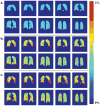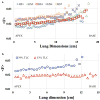Single-breath xenon polarization transfer contrast (SB-XTC): implementation and initial results in healthy humans
- PMID: 23011916
- PMCID: PMC3550007
- DOI: 10.1002/jmri.23823
Single-breath xenon polarization transfer contrast (SB-XTC): implementation and initial results in healthy humans
Abstract
Purpose: To implement and characterize a single-breath xenon transfer contrast (SB-XTC) method to assess the fractional diffusive gas transport F in the lung: to study the dependence of F and its uniformity as a function of lung volume; to estimate local alveolar surface area per unit gas volume S(A)/V(Gas) from multiple diffusion time measurements of F; to evaluate the reproducibility of the measurements and the necessity of B(1) correction in cases of centric and sequential encoding.
Materials and methods: In SB-XTC three or four gradient echo images separated by inversion/saturation pulses were collected during a breath-hold in eight healthy volunteers, allowing the mapping of F (thus S(A)/V(Gas)) and correction for other contributions such as T(1) relaxation, RF depletion and B(1) inhomogeneity from inherently registered data.
Results: Regional values of F and its distribution were obtained; both the mean value and heterogeneity of F increased with the decrease of lung volume. Higher values of F in the bases of the lungs in supine position were observed at lower volumes in all volunteers. Local S(A)/V(Gas) (with a mean ± standard deviation of S(A)/V(Gas) = 89 ± 30 cm(-1)) was estimated in vivo near functional residual capacity. Calibration of SB-XTC on phantoms highlighted the necessity for B(1) corrections when k-space is traversed sequentially; with centric ordering B(1) distribution correction is dispensable.
Conclusion: The SB-XTC technique is implemented and validated for in vivo measurements of local S(A)/V(Gas).
Copyright © 2012 Wiley Periodicals, Inc.
Figures










References
-
- Bouchiat M, Carver T, Varnum C. Nuclear Polarization in 3He Gas Induced by Optical Pumping and Dipolar Exchange. Phys Rev Lett. 1960;5(8):373–375.
-
- Albert MS, Cates GD, Driehuys B, Happer W, Saam B, Springer CS, Wishnia A. Biological magnetic resonance imaging using laser-polarized 129Xe. Nature. 1994;370(6486):199–201. - PubMed
-
- Driehuys B, Cates aGD, Miron E, Sauer K, Walter DK, Happer W. High-volume production of laser-polarized 129Xe. Appl Phys Lett. 1996;69(12):1668–1670.
-
- Ruset I, Ketel S, Hersman F. Optical Pumping System Design for Large Production of Hyperpolarized 129Xe. Phys Rev Lett. 2006;96(5):53002. - PubMed
-
- Mugler JP, Driehuys B, Brookeman JR, Cates GD, Berr SS, Bryant RG, Daniel TM, de Lange EE, Downs JH, Erickson CJ, Happer W, Hinton DP, Kassel NF, Maier T, Phillips CD, Saam BT, Sauer KL, Wagshul ME. MR imaging and spectroscopy using hyperpolarized 129Xe gas: preliminary human results. Magn Reson Med. 1997;37(6):809–815. - PubMed
Publication types
MeSH terms
Substances
Grants and funding
LinkOut - more resources
Full Text Sources

